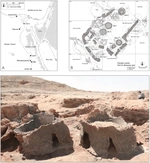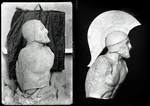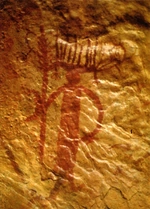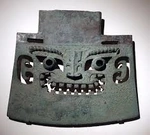The Old Nile River, Or Egypt And Its Measurements
As any life depends on water, so agriculture-based civilisations critically depended on the irrigation. And the River, in its turn, as a loving mum, with a readiness to give them all, humanity took the shores, where humans deployed their fields and farms, the water, which we use in melioration purposes, its countless fauna, we shamelessly consume with never telling thanks. As it is now, such it was...
The Main Chatting Theme at the Beginning of the 20th Century Among Europeans Was...?
In this chapter, we attempt to discover the main cultural background of the Ancient Egyptian civilisation, and the only purpose of the narration is to immerse the reader in the context of the culture. Only in this way will we be able to list the measurements as applicable units and trace their further evolution within other cultures...
Settlements And Habitant Groups On Nile Shore, Or Before The Kingdom Times Of Egypt

Proto Egyptians
Unfortunately, we have no clear evidence related to proto-Egyptian sites, and this is reasonably conditioned by later cultural layers, which mainly erase and intertwine the possible artefacts, potentially revealing much about the groups.
But, based on the logic of all other similar cultures’ evolution, we may firmly assert that they were. In order not to be compromised as suspicious writers, we mark all later context of this section as unproven narration, designed by the authors for clarification purposes only, and solely to expose to the readers our approach to hypothesis building, in cases when the scientific brain heavily strives from lack of facts.
Early Egyptians lived along the Nile Valley, from the Delta to Upper Egypt. Villages were small (hundreds to a few thousand people), with clustered mudbrick houses. Based on irrigated agriculture (wheat, barley, flax) and supplemented by fishing, hunting, and livestock. Some communities show specialization, e.g., Predynastic cemeteries with high-status grave goods.
Stratification in early sites, as these were communities of course, naturally took place, and at that time may only boast goods diversity, family consumption in everyday life, and grave richness with ritual artefacts. Related to site-times, scarcely may it be adoptable even to suppose some kind of cosmetics or ornaments, which are usually more related to ritual attributes than personal use.
The Oxford History Of Ancient Egypt (Unfortunately the comprehensive work is not freely accessible, but if you have an unrestrained desire to dive into the topic more deeply, we strongly recommend the publication)Cities, Settlements And State Formation, Brief Overview...

Cities and Settlements
Hierakonpolis (Nekhen): One of the largest Predynastic centres, with religious and administrative functions, early temples, and elite tombs.
Abydos: Necropolis and ritual centre with evidence of long-distance trade and centralized burials.
Naqada: Regional centres with pottery workshops and cemeteries showing social hierarchy.
Settlements were often clustered along Nile tributaries, reflecting control of water and land as key resources.
The Predynastic and Early Dynastic periods (Britannica, well developed , and detailed overview of the period, we recommend visit for more complex review the period)Hey, we are hearing: it is not necessary to urge us. Now is the time of Pre-Dynastic State Formation and Political Evolution!
By c. 3100 BCE, Upper and Lower Egypt show signs of unification under a single ruler (traditionally Narmer/Menes). The conditions, general, and historically defined as required, all were relevant to that period: requirements of controlling irrigation networks, defense against raiders and nomadic incursions, economic integration (trade, tribute), religious authority concentrated in a single hand (kingship and temples as administrative hubs).
You may consider several places of archaeological excavations as evidence of state evolution: Narmer Palette (ritual unification symbolism); fortifications at Hierakonpolis and Tell el-Farkha; elite tombs with standardized grave goods; early writing (tags, labels) indicating administrative record-keeping.
Now Is The Right Place for Mapping Egypt Development As State

Background
Badarian Culture (ca. 5500–4000 BC) placed at Middle Egypt, centred on Badari (Asyut area), mainly characterized with early agricultural villages; rudimentary craft specialization; copper use begins, without direct evidences of political structure.
So we may set the point as cultural and economic foundation of later Upper Egyptian societies.
Conditional Period
Naqada I (Amratian) Period, positioned at Upper Egypt (Naqada, Hierakonpolis, Abydos), may be characterised with increasing settlement hierarchy, long-distance trade with Nubia, Red Sea, and Levant, distinctive black-topped red ware pottery, early governmental institutions represented with local chiefdoms, and each settlement sovereign, but toughly interacted each other.
Lower Egypt: Maadi–Buto Culture occupied Nile Delta, centred around Maadi, Buto, and Heliopolis, had trading activity, predominately with Southern Levant (Canaanite ceramics found), settlements shaped in simple villages; less monumental craft output compared to Naqada
Political Consolidation (ca. 3500-3200 BC)
During socio-cultural evolution, it is an unavoidable process of establishing authority and attempts to take power, which grow from the early forms of leadership. Such behavior can be seen in Ancient Egyptian cities just before the formation of the Egyptian state, around 3500–3200 BC, when settlements in Upper Egypt were expanding northward. As evidence, we may consider the emergence of elite cemeteries (Hierakonpolis HK6, Abydos U Cemetery), the construction of fortified centres and proto-palatial structures, and excavations dated to this time showing the introduction of Mesopotamian motifs (niched façades, boats, animals, elite scenes).
There were several proto-kingdoms, which later acted as significant impacters in state formation, but for now, we simply list them. Abydos / Thinis (Upper Egypt, near modern Girga) — a probable future royal centre. Naqada — an important religious and cultural hub. Hierakonpolis (Nekhen) — the major ritual and political capital of the south. Nubt (Ombos) — a lesser centre near Naqada. Each controlled surrounding villages through kinship ties and tribute. Warfare and symbolic conflict, as seen in palette iconography, show a rising trend toward centralization.
Upper Egypt, political consolidation under Thinis/Abydos and Hierakonpolis. As evidences of the evolution we may consider royal iconography (White Crown (Upper Egypt), Red Crown (Lower Egypt)), proto-hieroglyphic writing (Abydos tomb U-j; labels, jars), seals and accounting systems emerge (administrative control of goods). The most well-known rulers are Scorpion I–II, Ka, Iry-Hor (sometimes called “Dynasty 0” kings). Northern regions represented with Buto and Maadi (still semi-independent), and subdued by southern forces around 3100 BC.
Measurements In Ancient Egypt
In this section, we explore all Egyptian measurement units, with attempts to trace their appearance in chronicles and possible relations with other cultures.
Length Units
Egyptians had a well-developed system of measurement, widely approved and standardized. It was closely aligned with the social structure and institutional authority, reflecting the centralized control of a single ruler who managed both the state and its administrative tools. Below, you will find a table listing the units of length with their approximate equivalents in modern measurements. Further on, we will provide additional explanations and some very interesting facts — so don’t switch over..!
| Unit | Egyptian / transliteration | In smaller units or relation | Approximate modern value |
|---|---|---|---|
| Digit / Fingerbreadth | ḏbꜥ (sometimes transliterated dbʿ, “digit”) | the basic unit (1) | ~ 1.875 cm (i.e. 0.01875 m) |
| Palm | šsp (shesep) | 4 basics | ~ 7.5 cm (0.075 m) |
| Hand / Handsbreadth | ḏrt (often “hand”) | 5 basics | ~ 9.38 cm (0.0938 m) |
| Fist | ḫfꜥ (or ꜣmm) | 6 basics | ~ 11.25 cm (0.1125 m) |
| Little Shat / Shat nḏs | šꜣt nḏs | 3 palms (12 basics) | ~ 22.5 cm (0.225 m) |
| Great Shat / Half-cubit | šꜣt ꜥꜣ (pḏ nḥs / pḏ nꜣs) | 3.5 palms (or 14 basics) | ~26.2 cm (0.262 m) |
| Foot | ḏsr (often “foot”, or “bent arm”) | 4 palms (16 basics) | ~ 30 cm (0.30 m) |
| Remen | rmn | 5 palms (20 basics) | ~ 37.5 cm (0.375 m) |
| Small / Short Cubit (meh nḏs) | mḥ nḏs | 6 palms (24 basics) | ~ 45 cm (0.45 m) |
| Royal / Sacred Cubit | mḥ (often mḥ nswt for “royal cubit”) | 7 palms (28 basics) | ~ 52.3 – 52.5 cm (0.523–0.525 m) |
| Senu (double royal cubit) | - | 14 palms (56 basics) | ~ 105 cm (1.05 m) |
| Khet (rod) | ḫt | 100 cubits | ~ 52.3 m (i.e. 100 × royal cubit) |
| Cha-ta (“field-length”) | - | ~ 10 khet (~ 1000 cubits) | ~ 520 m (variable by period or region) |
| Iteru | - | 20000 Royal Cubit | ~ 10.5 km (10500 m) |
Units Apearance, And Main Applications
Royal cubit (meh-nswt / mahe)
- - Old Kingdom, ~2700 BCE (Step Pyramid of Djoser)
- - Architectural measurements show use of the royal cubit (~52.3-52.5 cm), subdivided into 7 palms × 4 basics.
Palms, digits (basic), fingers (“shesep”, “djebâ”, etc.)
- - Early Dynastic / Old Kingdom period (~Early 3rd millennium BCE)
- - Palms = 4 digits etc., seen on measuring rods, in architectural plans etc. The Palermo Stone records Nile‐flood height as “6 cubits and 1 palm” in Early Dynastic period.
Knotted cords / ha‘t (land-measuring ropes)
- Middle Kingdom / perhaps earlier, but clearly attested by Middle Kingdom (~2000-1800 BCE)
- Used for measuring land, surveyed lengths, etc.
Seked (slope measure for pyramid faces)
- Old Kingdom, Great Pyramid (~2550 BCE) for Khufu’s pyramid, etc.
- The seked of ~5 palms and 2 digits is calculated from modern survey of the pyramid faces.
Measurement of large lengths / khet (100 cubits etc.)
- Old Kingdom, used in land measurement and architecture; rods, cords, etc.
Comparisons Between Egyptian vs Sumerian Units
We try to trace relation with Sumerian And Egyptian units, but fairly speaking this is not accurate scientifcally adoptable approach, so look at this atemption as for pure experiment
| Cubit sizes are similar | - Egyptian royal cubit ~ 52.3-52.5 cm; Sumerian Nippur cubit ~ 51.8-52 cm. |
| - These could reflect independent developments around human-body proportions rather than direct borrowing; proximity/trade could have allowed influence, but direct evidence (textual or archaeological) of borrowing is scarce. | |
| Subdivisions | - Both systems subdivide cubit into smaller units (palms, digits or their equivalents) – similar division structures. |
| - The exact structure differs; for example, Egyptian has 7 palms × 4 digits = 28 digits; the Sumerian rod had 30 “digits” in some records. So structure is close but not identical. | |
| Use of rods / standard measures | - Both cultures had physical standard rods or bars for length; for example, the Nippur copper alloy bar, Egyptian cubit rods from tombs (e.g. of Maya, or Kha) |
| - We don’t have evidence that the Egyptian rods were copies of Mesopotamian ones, or vice versa; also the material, calibration, context differ. | |
| Temporal overlap | - Both systems are attested in the 3rd millennium BCE. Sumerian standards (2650 BCE), Egyptian royal cubit in Old Kingdom (~2700 BCE) etc. |
| - Overlap in time does not prove diffusion; geographical separation and nature of communication matter. No unambiguous Mesopotamian text saying “we adopted Egyptian cubit” or the reverse. | |
| Trade / cultural interaction | - There is evidence of trade networks across the Near East which could allow for transmission of measurement ideas. Weighing technology etc. show diffusion patterns. For example, Bronze‐Age weight systems show similar units in western Eurasia. |
| - However, precise measurement standards tend to be local and possibly resilient to external influence unless political or economic dominance occurs. Also many measurement units show convergent development (people measuring human bodies, ropes, rods, etc.) rather than borrowing. |
It is well-attested that both Egyptians and Sumerians had cubit-scale units with similar lengths, and used physical rods and standard measures as early as the 3rd millennium BCE. The Egyptian royal cubit and the Sumerian cubit are close in value (≈ 52 cm vs ≈ 51.8 cm) which suggests that they may have drawn on similar anthropic bases (arm length, etc.). But there is no conclusive evidence that one borrowed from the other in terms of that specific standard. For other units (area, volume, weights), there is more evidence of independent development but also of later standardisation that may have been influenced by broader Near Eastern practices. In some cases, measurement systems show diffusion of ideas (e.g. use of weights, balance scales, standardized merchandise, etc.), but precise unit equivalences and calibrations are more likely to be local or adapted rather than copied wholesale.
This article is part of a long-read publication. [Go to the full version →]







This chapter devoted to two cultures, Babylonia and Persia, and here uncover why...

And here the place we should turning backward, to culture, already passed but under other angle...






